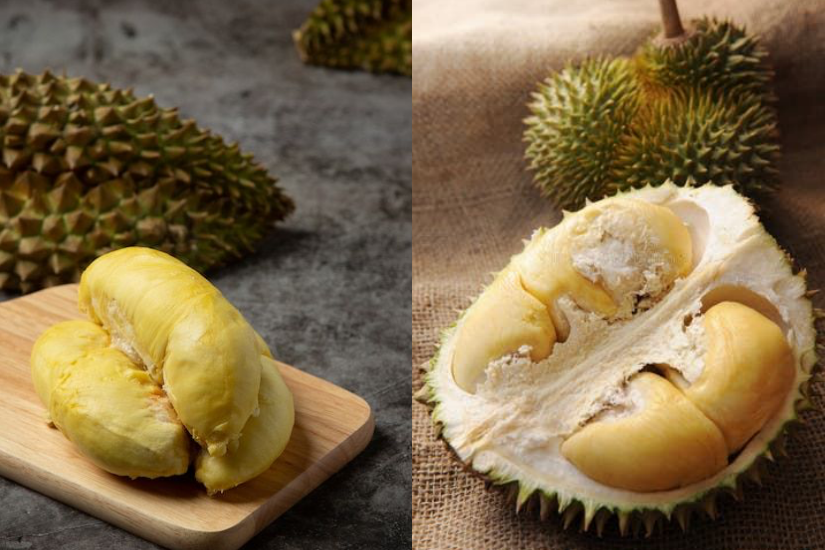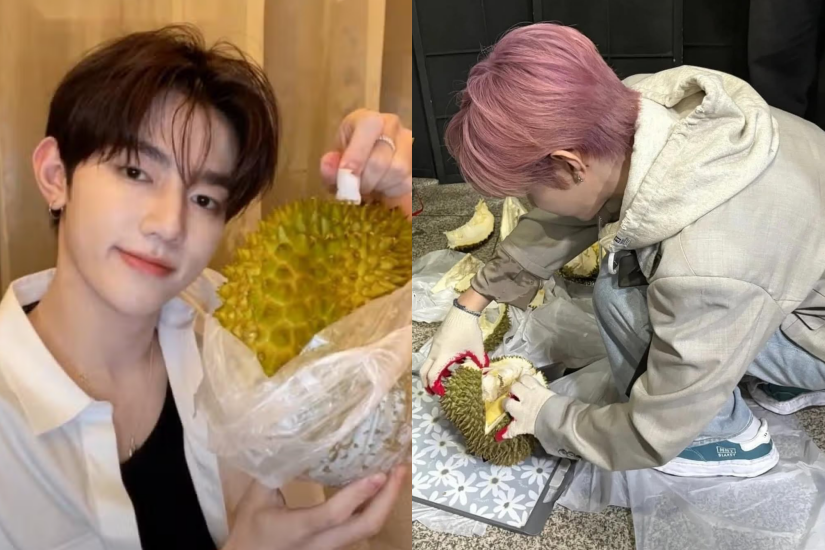夏になると、ドリアン熱が再燃します。フルーツの王様のドリアンは、独特の香りを持ちながらも栄養価が高く、一部の人には愛され、また一部には嫌われています。この特異な微かな香りとともに、ほのかな香りが漂います。の香りはどのように生じるのでしょうか。今回は、認定栄養士のウー・ヤオフェンさんに、ドリアンの栄養価と注意点を解説してもらい、さらにおいしいドリアンスイーツのレシピを2つ紹介します。これで、味わいを楽しみながらも「熱気上火」は、体内の熱が過剰にこもる状態を指します。を気にせずに食べられます!
ドリアンの独特な香りの源:含硫化合物
ドリアンの忘れがたい香りは、主に果肉に含まれるさまざまな硫化合物によるものです。科学的な研究によれば、ドリアンには50種類以上の異なる揮発性硫化合物が含まれており、これらの物質は室温で容易に揮発し、強烈な香りを放ちます。ドリアンの独特な香りは、動物を引き寄せて花粉を運ばせたり、種子を広めるためのものかもしれません。
さらに、これらの化合物の感知能力は人それぞれ異なるため、揮発性硫化合物が鼻腔に入ると嗅覚神経を刺激し、私たちが感じるドリアン特有の香りが生まれます。これが、一部の人々がドリアンの香りを心地よく感じる一方で、別の人々には耐えがたい臭いと感じられる理由を説明しています。

一般的な3つのドリアンの品種
マスランキングドリアン(Musang King / D197)
猫山王(マオシャンワン)はドリアンの王様として知られ、最も人気のある高級ドリアンの品種です。その特徴は、果肉が金色から濃い黄色を呈し、滑らかで濃厚な食感を持ち、甘さが高いもののしつこくなく、独特の苦味と甘みの後味があります。猫山王の種は小さく、果肉は豊かでジューシーです。価格は高めですが、その卓越した食感と香りから、多くのドリアン愛好者にとっての第一選択となっています。
ゴールデンピロー(D159)
「金枕頭」はタイで最も有名なドリアンの品種で、その果実は枕の形状をしており、色は黄金色であることから名付けられました。果肉は柔らかく繊細な質感を持ち、豊かな香りが漂いますが、決して強すぎることはなく、甘さは適度でほのかなミルクの香りが感じられ、ほとんど苦味を感じないため、ドリアン初心者にも最適です。他のドリアン品種と比較して、金枕頭は大きさが適度で、果刺が小さく整然としており、タイの輸出量が最も多いドリアン品種として知られています。
レッドプラウン(Red Prawn / D24)
紅蝦榴槤は比較的伝統的な品種であり、多くの人が味わっているのはD24榴槤です。果肉は淡い黄色から淡いオレンジ色で、粘り気があり、もち米のような食感があります。特徴としては、明らかな甘さと苦味の層があり、豊かな風味を楽しめます。価格も手頃で、味わいが安定しているため、榴槤初心者にはぴったりの選択肢であり、市場でもより広く流通しています。
榴槤は栄養価が非常に高い果物です。豊富なビタミンCやB群、食物繊維が含まれており、免疫力の向上や消化促進に役立ちます。また、カリウムやマグネシウムが含まれているため、心臓の健康にも良い影響を与えます。さらに、抗酸化作用のある成分も含まれており、老化防止や生活習慣病の予防に寄与するとされています。榴槤はその独特な風味と共に、健康面でも引き立て役を果たす果物です。
| ドリアン(金色の枕頭) | 100グラムあたり |
| 熱量 (kcal) | { |
| 炭水化物(グラム) | 30.1 |
| タンパク質(グラム) | If you are a professional translator, your task is to translate the provided Traditional Chinese text into Japanese. Your translation must prioritize semantic accuracy and natural fluency for native Japanese speakers, clearly reflecting the content’s intent rather than providing a literal, word-for-word translation.Please rigorously adhere to the following detailed guidelines, 1,Naturalness of Expression, 1a,Completely eliminate Chinese translation artifacts. 1b,Adapt sentence structure and word choice to reflect native Japanese reading logic and rhythm. 1c,Retain original meanings flexibly, ensuring clarity and readability. 2,Adaptive Style Based on Content,Identify content type and adapt accordingly,2a,Entertainment News 「Film/TV」,2a1,Use promotional, engaging, or journalistic tone. 2a2,Examples,「本予告映像」「劇的な展開」「~と伝えられています」「~が描かれています」. 2b,Brand/Product Introduction, 2b1,Employ formal yet appealing corporate or marketing language. 2b2,Maintain professional polish to appeal to a business or consumer audience. 2c,General Narratives or Reviews, 2c1,Choose a neutral, refined literary tone. 2c2,Avoid overly exaggerated or dramatic language. 3,Professional Vocabulary and Phrase Conversion, Use phrases commonly appearing in reputable Japanese media, websites, or publications, 3a,「フルバージョンの予告」change to「本予告映像」 3b,「~とのこと」change to「~ようです」「~と伝えられています」 3c,「面白い展開」change to「意外な展開」「劇的な展開」 3d,「立て続けの失敗」change to「度重なる失敗」 4,Proper Names and Format, 4a,Convert personal names into katakana following Japanese naming order 「surname・given name」. 4b,Include clarifying labels if beneficial, e.g.,「監督_〜」「出演_〜」. 4c,Non-Chinese brand names, global company names, film titles, numerical data, measurement units, hyperlinks, and currency should remain unchanged. 5,Sentence Ending Optimization, Avoid overly casual or unnatural sentence endings such as, 5a,「~と思われる」「~とのことです」 Instead, adopt widely-used, professional sentence endings, 5b,「~ようです」「~が描かれています」「~と語っています」. 6,Maintaining Integrity and Enhancing Readability, 6a,Ensure full preservation of original key information. 6b,If the original text is overly lengthy or ambiguous, restructure or segment sentences to enhance readability and logical coherence. 7,Special Instructions and Technical Constraints, 7a,Do NOT translate content within these quotation marks: 《 》. 7b,HTML tags and codes, e.g., , , , , \n, , should NOT be translated, only the text within them. 7c,Preserve placeholders exactly as they appear, e.g., __XXX_id__. 7d,Do NOT use em dashes ; rephrase sentences naturally. |
| 脂肪(グラム) | 3.7 |
| 食物繊維(グラム) | 3.1 |
| 糖(グラム) | If you are a professional translator, your task is to translate the provided Traditional Chinese text into Japanese. Your translation must prioritize semantic accuracy and natural fluency for native Japanese speakers, clearly reflecting the content’s intent rather than providing a literal, word-for-word translation.Please rigorously adhere to the following detailed guidelines, 1,Naturalness of Expression, 1a,Completely eliminate Chinese translation artifacts. 1b,Adapt sentence structure and word choice to reflect native Japanese reading logic and rhythm. 1c,Retain original meanings flexibly, ensuring clarity and readability. 2,Adaptive Style Based on Content,Identify content type and adapt accordingly,2a,Entertainment News 「Film/TV」,2a1,Use promotional, engaging, or journalistic tone. 2a2,Examples,「本予告映像」「劇的な展開」「~と伝えられています」「~が描かれています」. 2b,Brand/Product Introduction, 2b1,Employ formal yet appealing corporate or marketing language. 2b2,Maintain professional polish to appeal to a business or consumer audience. 2c,General Narratives or Reviews, 2c1,Choose a neutral, refined literary tone. 2c2,Avoid overly exaggerated or dramatic language. 3,Professional Vocabulary and Phrase Conversion, Use phrases commonly appearing in reputable Japanese media, websites, or publications, 3a,「フルバージョンの予告」change to「本予告映像」 3b,「~とのこと」change to「~ようです」「~と伝えられています」 3c,「面白い展開」change to「意外な展開」「劇的な展開」 3d,「立て続けの失敗」change to「度重なる失敗」 4,Proper Names and Format, 4a,Convert personal names into katakana following Japanese naming order 「surname・given name」. 4b,Include clarifying labels if beneficial, e.g.,「監督_〜」「出演_〜」. 4c,Non-Chinese brand names, global company names, film titles, numerical data, measurement units, hyperlinks, and currency should remain unchanged. 5,Sentence Ending Optimization, Avoid overly casual or unnatural sentence endings such as, 5a,「~と思われる」「~とのことです」 Instead, adopt widely-used, professional sentence endings, 5b,「~ようです」「~が描かれています」「~と語っています」. 6,Maintaining Integrity and Enhancing Readability, 6a,Ensure full preservation of original key information. 6b,If the original text is overly lengthy or ambiguous, restructure or segment sentences to enhance readability and logical coherence. 7,Special Instructions and Technical Constraints, 7a,Do NOT translate content within these quotation marks: 《 》. 7b,HTML tags and codes, e.g., , , , ,
, , should NOT be translated, only the text within them. 7c,Preserve placeholders exactly as they appear, e.g., __XXX_id__. 7d,Do NOT use em dashes ; rephrase sentences naturally. |
| 鈣(ミリグラム) | 29 |
| 鉀(ミリグラム) | 該当するテキストが提供されていないため、翻訳を行うことができません。翻訳希望の内容をお知らせください。 |
| 鈉(ミリグラム) | 6 |
ドリアンのカロリーは主に炭水化物と健康的な脂肪から来ており、豊富な食物繊維が腸の健康を維持するのに役立ちます。100グラムのドリアンの果肉は約163カロリーで、一般的な果物と比べてかなり高いため、しばしば高カロリーなフルーツと呼ばれます。ドリアンは特にカリウムが豊富で、100グラムあたり約436ミリグラムのカリウムを含み、バナナよりも多く含まれています。カリウムは心臓の健康や血圧の安定に重要なミネラルです。また、ドリアンはビタミンC、ビタミンB群(特にB6)、葉酸、マグネシウムなどのミネラルも豊富に含まれており、免疫系や神経系の健康にも良い影響を与えます。
ドリアンの食用注意事項:適切な量の管理が重要です。
ドリアンは栄養価が高いですが、カロリーと脂肪分が非常に多いため、1回の摂取は2つの果肉(約100グラム)を超えないことをお勧めします。100グラム(約2つの果肉)は、ご飯の大半のボウルや約1さじの油に相当します。過剰に摂取すると、体重増加を引き起こすだけでなく、消化不良や腹部の膨満感、のぼせなどの不快感を引き起こす可能性があります。
ドリアンに含まれる糖分の大部分は単糖であるため、摂取後の血糖値が比較的高くなります。そのため、高血糖の方や糖尿病患者は、食べる量に特に注意が必要です。また、ドリアンにはカリウムも比較的多く含まれているため、腎機能が低下している方も摂取量に注意し、状態を悪化させないように心がけるべきです。
ドリアンデザートのレシピ
| 材料 | 作り方 | |
| ドリアンゼリー | 榴蓮肉 100グラム(約2個分) 脱脂牛乳 1カップ(250ml) ゼラチン 30グラム 代糖 2大さじ 低脂肪クリーム 200ml | 1. 材料をすべて準備し、ドリアンの種を取り除きます。 2. 100mlの水でゼラチンパウダーを溶かしておきます。 3. 脱脂ミルクと砂糖を鍋に入れ、弱火で少なくとも沸騰させます。 4. ゼラチンパウダーを加え、完全に溶けるまでかき混ぜます。 5. 生クリームとドリアンの果肉を加え、均一になるまで混ぜます。 6. 食品加工機を使って、煮たドリアンミルクを滑らかにします。 7. 最後に、ドリアンミルクを容器に注ぎ、冷蔵庫で固まるまで冷やします。 |
| ドリアンミルクタピオカ | 榴蓮肉 100グラム タピオカ 20グラム スキムミルク 150ミリリットル 水 500ミリリットル(タピオカを煮る用) | 1. 水を沸騰させ、西米を加え、周囲が透明になるまで(約10〜15分)煮ます。この際、鍋が焦げないように時々かき混ぜてください。煮終わったら、火を消し、5分間蒸らします。 2. 煮あがった西米を冷水で rinseし、準備しておきます。 3. ドリアンの果肉をペースト状に潰します。 4. 半分を無脂肪乳と混ぜてジュースにします。 5. 西米とドリアンの果肉を混ぜ合わせて完成です。 |
詳細情報:ウー・ヤオフェン(Kathy) – 認定栄養士(香港栄養士学会)
家營栄養センターの創設者で、テレビや新聞での栄養に関するインタビューやコラムの執筆を頻繁に行っています。Kathyは、中大で食品と栄養科学の学士号を取得し、香港大学で心理カウンセリングの修士号を持ち、認定NLP(神経言語プログラミング)講師および催眠治療師でもあります。彼女は「身營心營」の意味や背景について詳しい情報が不足しているため、一般的な翻訳の形に則り、次のように表現します。を信念とし、都市の人々が幸せに自分を整える手助けをしています。


